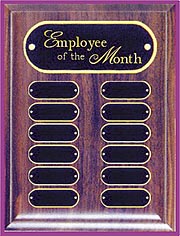
Personal Motivation
Paul Meyer of the Success Motivation Institute has some thoughts to share with us regarding personal motivation:
- Self-motivation is the power that raises you to any level you seek.
- It is impossible to motivate anyone else until you’ve learned to motivate yourself.
- Self-motivated people make commitments; ordinary people make promises.
- The power of personal motivation comes from a definite, personalized plan of action and the application of that plan every single day.
- Ultimately, what we get out of life depends on how well we match what we want with self-motivation.

Tough Decisions
As deputy secretary of state for the Reagan administration, John Whitehead has considerable experience making tough decisions on delicate matters. He says that critical decisions require both time and strong support.Stay cool and don’t rush things, he advises. There usually is more time to gather information and weigh options than you think. Try and think of other people who can help you with the decision. You never know who might have some valuable information that you could use.
Whitehead’s experience has shown him that how a decision is carried out is at least as important as the decision itself. “Bad decisions, if carried out well, can turn out to be successful, while a good decision, if carried out poorly, can turn out a flop.”

Why We Have Meetings
Business meetings satisfy deep-seated (and sometimes twisted) psychological needs, according to noted author Stephen Baker. He says the main purposes for meetings are to provide opportunities for:
- the consumption of large quantities of coffee and doughnuts at company expense
- saying hello to colleagues you haven’t seen since the previous day’s meeting
- telling really bad jokes
- looking and acting important
- making others seem unimportant
- getting away from the desk
- faking expertise in subjects you know nothing about and/or inventing new words
- much complaining
- listening to other people’s ideas that you can take credit for later
Baker points out that our national economy is based on a 40-hour workweek. “Without all the meetings,” he explains, “This would dwindle to a few hours at the most. The whole system as we know it would collapse.
“It is natural to want to gather. Baboons and penguins have been doing it for years. But credit for refining the technique goes to humans. They are the ones who invented the chair, the tabletop and the conference room, thus making it possible to hold meetings from morning to night, five days a week.”

Healthier Golfing
As if it didn’t already inflict enough damage mentally, playing golf can cause physical harm as well. Sixty-two percent of golfers who take to the links twice a week or so have sustained some kind of injury from playing the game.The Johns Hopkins Medical Center studied more than 1,000 golfers and found the most common cause of injury is excessive play. The next most common cause of injury is shoddy swing mechanics.
For gentleman swatters, the body parts that are abused the most are – in descending order of frequency – the back, elbow, hand and wrist, shoulder and knee. Lady linksters usually will suffer maladies affecting their elbows, backs, shoulders, hands and wrists and knees.
Follow these helpful hints and you’ll stand a better chance of staying off the 15-day disabled list:
- Loosen up before you begin. Slowly bend forward from the waist with your knees bent. Let your arms and head dangle for 15 seconds. Do this several times.
- Just before teeing off, swing your club like a baseball bat, gradually extending your swing.
- When teeing your ball or picking up a ball or club – or anything else for that matter – bend your knees instead of your back.
- Flex your knees as you putt.
- From time to time, swing your club in the opposite direction – if you’re right-handed, practice swinging left-handed.
- To help maintain proper upright posture, walk holding a club across your back in the crook of your elbows.

Meat Consumption at Record High
Now more than ever, America is a nation of meat eaters. Last year, total meat consumption (red meat, poultry and fish) reached 195 pounds (boneless, trimmed-weight equivalent) per person – that’s 57 pounds more than the average annual consumption in the 1950s. Each American consumed an average of 7 pounds more red meat than in the 1950s, 46 pounds more poultry and 4 pounds more fish and shellfish. Rising consumer incomes, especially with the increase in two-income households, and meat prices in the 1990s that were often at 50-year lows when adjusted for inflation, explain much of the increase in meat consumption. In addition, the meat industry has provided scores of new brand name, value-added products processed for consumers’ convenience, as well as a host of products for foodservice operators.Nutritional concern about fat and cholesterol has encouraged the production of leaner animals (beginning in the late 1950s), the closer trimming of outside fat on retail cuts of meat (beginning in 1986), the marketing of a host of lower fat ground and processed meat products and consumer substitution of poultry for red meats since the late 1970s – significantly lowering the meat, poultry and fish group’s contribution to total fat and saturated fat in the food supply. Despite near record-high per capita consumption of total meat last year, the proportion of fat in the U.S. food supply from meat, poultry and fish declined from 33 percent in the 1950s to 24 percent. Similarly, the proportion of saturated fat contributed by meat, poultry and fish fell from 33 percent in the 1950s to 26 percent.

Being Careful with Recognition Awards
If you want to boost worker productivity, don’t make the common mistake of handing out recognition awards to one or two of your star employees in hopes that others will take the hint and follow their example. It doesn’t work.“To improve productivity, you have to foster teamwork,” notes Bonnie Donovan of the American Productivity Center. “Singling out the superstars tends to undermine team spirit. If you really want to improve performance, then the rewards have to go to anyone who attains a given level of performance, and that level should be within the reach of a lot of people.”
This doesn’t mean that recognition awards serve no good purpose. You can use them to create role models and to give employees a sense of the company’s priorities – provided you use objective, clearly defined criteria. But too many companies don’t. As a result, “people don’t know what they have to do to receive a recognition award,” Donovan says. “You’ve set up a target that not everyone knows how to aim for.”
Report Abusive Comment